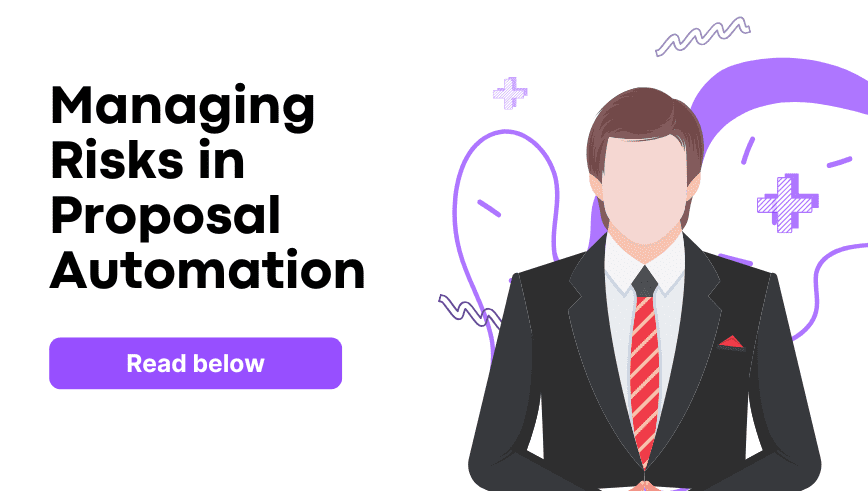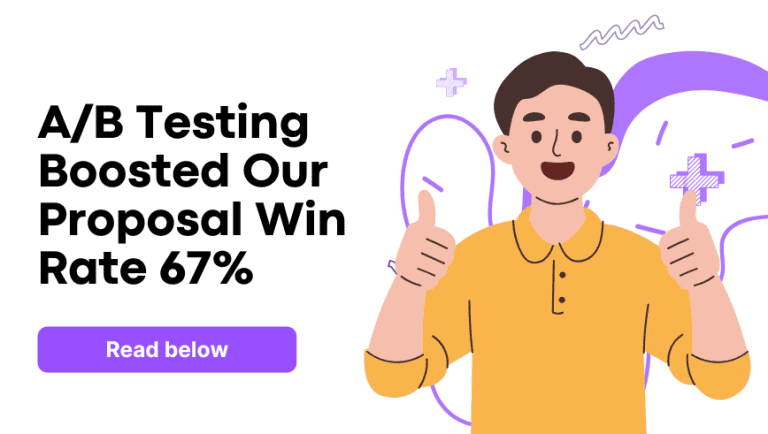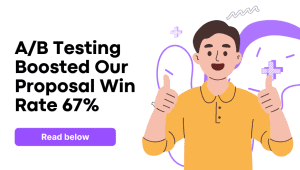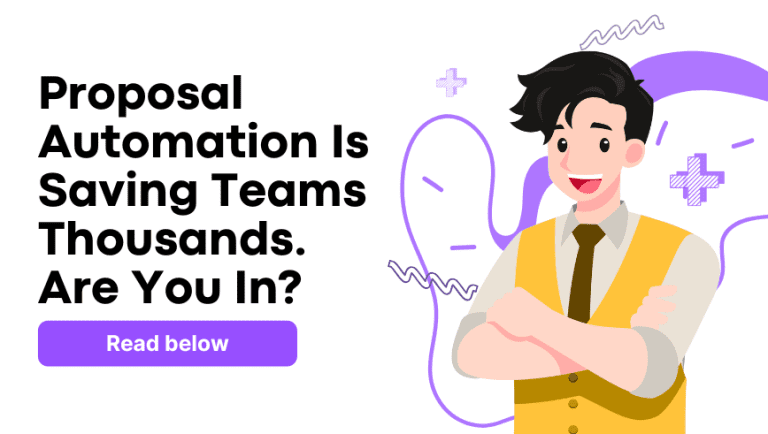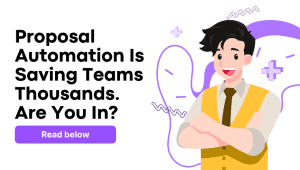Every once in a while, we meet a potential customer who’s almost sold on the idea of proposal automation. They’ve seen the time savings. They’ve heard about faster sales cycles. But then comes the hesitation.
It’s not about features. It’s not about pricing.
It’s about trust.
And that hesitation there, well, it makes sense. Businesses are becoming more careful. Automation is about more than speed or efficiency. It’s also about keeping your data, your clients’ information, and your credibility safe.
At Proposal.biz, we’ve seen those concerns firsthand. We’ve been in conversations where security questions held up final decisions. Teams have asked about compliance, access, and data sharing. This blog walks through our insights, drawn from our work in the proposal automation space.
What Proposal Automation Really Involves
Sure, proposal automation is about creating documents and varied business proposals. But it includes a lot more than that. It connects with CRMs, pricing tools, document libraries, and approval workflows. It pulls in client names, contract terms, product specs, and sometimes even proprietary information. The convenience is clear. So is the potential risk.
That’s where risk management automation comes into the picture. It’s about designing a secure foundation, not patching issues later.
Designing Security From the Start
Our team at proposal.biz didn’t treat security like a plugin. We treated it like architecture. We asked questions before writing any code:
- Who should have access to each part of the proposal process?
- What information should be stored, and how should it be stored?
- How can we keep audit trails readable and useful?
This gave rise to our internal security framework. We shaped it around four core principles:
- Minimal Permissions
Everyone gets access only to the data and tools they need. - Clear and Searchable Logs
Every action is recorded, with context and user details. - Built-in Proposal Data Protection
Encryption, redaction, and data classification are foundational. - Alignment with Regulations
The system is compatible with compliance structures like SOC 2 and GDPR. The experience remains easy to navigate.
We treated security like product design. Usable, understandable, and trustworthy.
Understanding the Common Threats
Proposal automation touches sensitive business information. Even small oversights can lead to trouble.
Here are some of the threat areas we’ve studied:
Unauthorized Access
It happens when old users still have login access. Or when new users get default admin rights. Without role-based logic, proposal automation systems can open paths that weren’t meant to be open.
Unsecured Data Transfers
Modern proposals often include embedded pricing tools or third-party access links. If those paths don’t run through encrypted channels, Proposal Data Protection gets weakened.
Poorly Managed Integrations
Proposal tools that talk to CRM and billing systems use APIs. When those APIs aren’t secured or monitored, they introduce gaps that attackers can use.
Unclear Compliance Boundaries
Especially in healthcare, finance, or government contracting, one clause in a proposal can trigger audits. RFP risk management needs to guide the system logic and not just inform the team.
Is proposal automation Safe for Confidential Client Data?
We often get asked: Can proposal automation safely handle sensitive information?
The answer depends on how the system is designed. At proposal.biz, we focus on proposal data protection from the ground up. Every proposal may include pricing strategies, client-specific clauses, or contract terms. Without proper safeguards, this data can become exposed during access, storage, or transmission.
Here’s how we’re addressing that:
- Data encryption during transfer and at rest.
- Access control settings that define exactly who can view or edit what.
- Redaction features to hide certain details from external recipients.
- Secure backups to ensure data is never lost due to errors or threats.
Any business details with the creation of different business documents that may cause damage to the clients’ business if leaked. This approach to proposal automation doesn’t just help reduce risk. It makes it easier for teams to work confidently, knowing their client information stays protected.
What Happens If There’s a Breach?
No system is ever immune to risk. That’s why risk management automation isn’t about hoping for the best. It’s about planning for every situation.
If a breach or suspicious activity is detected, proposal.biz will:
- Send immediate alerts to the admin and security contacts.
- Suspend access from the flagged source until verified.
- Offer audit trails that show the full path of access, edits, or downloads.
- Provide data recovery options to restore the last clean version.
- Help with any reporting needed for rfp risk management or compliance purposes.
This proactive mindset builds trust, not just within your team, but with your clients and partners too.
Worried This Could Happen? Here’s How Good Software Handles It
Let’s say you’re working on a big deal. You’ve pulled in product pricing from your internal systems, added custom terms for the client, and shared the draft with your team. A few days later, someone forwards that draft outside the company by accident.
If your platform has no controls, you’ll never know who opened it or where it landed. This is the kind of moment that makes people hesitate before trusting automation.
That’s why the best Proposal Automation platforms come prepared:
- Every shareable link is tracked, so you can see when and where it was accessed.
- Access can be revoked instantly, even after the proposal is sent.
- Audit logs show every viewer and editor, with timestamps.
- Proposal data protection tools like watermarking or download-blocking help limit misuse.
What looks like a disaster in one tool becomes a manageable moment in another. That’s the difference between using automation and using automation designed with risk in mind.
Where Proposal Automation and Risk Management Connect
Our team believes risk management automation makes sales faster. When a proposal platform is trusted, it’s used more confidently.
So we built out layers that support security without slowing the process.
- Live Threat Alerts
Activity monitoring that flags suspicious behavior and sends updates instantly. - Role-Specific Proposal Views
Proposal content adapts to the reader’s role. Clients, sales leads, and legal teams all see the right information. - Intelligent Risk Flags
Content that includes non-standard clauses or sensitive terms gets flagged before submission. - Compliance Profiles
Users can apply compliance presets. The system adapts data handling and permissions accordingly.
These elements were shaped by real conversations and fieldwork. They serve clients who want proposal automation that respects their responsibilities.
How Can I Control Who Sees What in My Proposals?
Granular control is a must. Proposal automation should support the way you manage roles internally, while also protecting what gets shared externally.
Here’s how proposal.biz is structured:
- Role-based visibility: Different users can view different proposal sections.
- View-only or comment-only options: For finance, legal, or external stakeholders.
- Smart expiry links: So proposals can’t be accessed indefinitely.
- Download restrictions: Limit or disable downloads for sensitive drafts.
This adds a powerful layer of Proposal Data Protection and supports teams that operate across multiple departments or regions. When everyone sees only what they’re supposed to, mistakes and risks go down.
Learning From Clients Who’ve Been There
Some of our earliest clients had used other automation platforms. What they found missing wasn’t speed. It was clarity. When audits came or when they needed records, they couldn’t find what they needed.
That experience helped shape how we approached Proposal Data Protection. We listened to what didn’t work. We designed with those stories in mind.
We saw that proposal automation needed a stronger foundation. Not just for security, but for confidence.
What Proposal Tools Can Actually Do Today
We’ve come a long way from manually stitching together Word docs and spreadsheets. Today’s Proposal Automation tools are surprisingly capable when built with real users in mind.
Here’s what’s possible right now:
- Pull live pricing from your CRM, so your sales team always sends accurate numbers.
- Insert legally approved clauses automatically, based on deal size or client industry.
- Tag proposal sections so legal, finance, and product teams only review what matters to them.
- Track open rates, read time, and clicks, so you know which sections your client actually read.
- Trigger internal follow-ups when a proposal sits unopened for 48 hours.
- Add e-signatures and auto-store signed proposals, all within the same system.
- Map proposals to compliance frameworks using presets tied to your industry.
This isn’t just document generation. The proposal builder tool and the RFP process are a way to bring consistency, control, and insight into your sales and client onboarding processes. We’re building proposal.biz with all of this in mind and simplifying the parts that usually cause friction.
Can Proposal Automation Help With Compliance?
Many industries rely on strict compliance standards. Proposal automation can help simplify that process, instead of making it more complex.
Our platform helps by:
- Creating compliance presets (Hyperlink HIPAA Blog here) for GDPR, HIPAA, or SOC 2 logic.
- Supporting data classification tags that flag sensitive proposal fields.
- Offering audit-ready logs of every action taken in the proposal process.
- Aligning with rfp risk management standards in regulated industries.
This approach makes proposal automation a partner in compliance, not just a document tool. When compliance becomes easier to manage, teams move faster without stepping outside the lines.
Proposal Automation That Acts With Awareness
Risk exists. But when a system recognizes that early, it becomes a strength.
We’re focused on transparency. Teams need to know what data is being handled, how permissions work, and what the limits are. That’s how proposal automation becomes part of trusted workflows.
The best proposal tools support their users with clarity. That’s what closes deals faster.
Checklist: What to Look For in a Secure Proposal Automation Tool
If you’re exploring proposal automation, use this checklist to guide your decision. These are the areas we prioritize in proposal.biz because they’re what businesses care about most:
- Real-time risk management automation
- Role-based access control
- Data encryption during upload/download
- Audit trails that are human-readable
- Integration security for APIs
- Proposal data protection at every layer
- Regulatory presets for rfp risk management
- Suspicious activity alerts and logs
- Customizable proposal permissions and expiry controls
- Clear control over data storage, export, and deletion
If a platform checks these boxes, it’s built with your business safety in mind.
A Bit About Proposal.biz
At Proposal.biz, we’re still shaping our proposal automation platform. Every feature is measured against trust. Every decision is based on client expectations.
We look at our own proposal needs and ask, “Would this give us peace of mind?” If not, we refine it.
We’re not focused on adding more features for the sake of it. We’re focused on alignment. Between security and sales. Between Proposal Data Protection and ease of use. Between rfp risk management and real-time proposal creation.
Building Security Into Every Step
Proposal automation isn’t only about speed. It’s about trust. Businesses that rely on proposals for growth also need reliability, clarity, and security.
We’re building a system that does just that. One that takes Proposal Data Protection seriously, supports real-world rfp risk management, and allows teams to work without hesitation.
If that’s what you’re looking for, stay close. Our platform is in development. But the foundation is solid. And your feedback can help shape what comes next.
Let’s build something responsible. Let’s build something useful. Let’s build it together.
